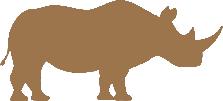
SWT/KWS MT KENYA MOBILE VETERINARY UNIT
FEBRUARY 2024




4 Cases in February 2 Poaching Cases
February Report by Dr. Dr Poghon J

Rhino Case
During the month of February 2024, there was a decline in the number of cases in the Mt. Kenya and Southern Laikipia area.
The veterinary unit was involved in snare removal from a giraffe in Mwea and a waterbuck at Kisima in Meru County. The unit also attended to a white rhino bull with fight wounds at Lewa Conservancy. Additionally, the vet unit was involved in collaring baboons at Mpala Research Center.
Acknowledgement
The Mt. Kenya Mobile Wildlife Veterinary Unit thanks the Senior Assistant Director, Mountain Conservation Area and the Head of Veterinary Services, Kenya Wildlife Service for providing leadership and technical expertise. The veterinary team also appreciates The Sheldrick Wildlife Trust (SWT) for providing the financial and logistical support that enables the Unit to fulfil its mandate.
Case Details
1-Feb-24
Conservancy
A snared giraffe with a tight wire snare that had cut deep into the limb causing lameness
A snared waterbuck was reported to be recumbent by the roadside at Kisima, along the the Nanyuki-Isiolo road.
The rhino had been involved in a territorial fight with another bull and had sustained injuries on the lower lip and multiple wounds on the head
Treated 21-Feb-24
The baboons were captured using cuboidal mesh cages with a trap door and collared Task Successful
Date Species Area Found Reason for Intervention Outcome
1
Giraffe Mwea National Reserve Snared
Successfully
Waterbuck Maralal
Snared
Poaching
Rhino
Successfully
Baboon
Treated 21-Feb-24
Conservation Area
Death 21-Feb-24
White Lewa
Natural Causes
Mpala Ranch Collared
Introduction
February 2024

SWT/KWS Mt Kenya Mobile Vet Unit Treatment Locations
Giraffe
Snared
Mwea National Reserve
A report was made by the warden of Mwea National Reserve of a snared Giraffe with a tight wire snare that had cut deep into the limb causing lameness.


Immobilisation, examination and treatment
A dart was prepared with 12mgs of Etorphine alone. The giraffe was approached by car and darted on the rump after which it ran into some bushes and fell down. The anaesthesia was reversed quickly using Naltrexone and the giraffe held down by the rangers.
A tight wire snare on the right hind limb was cut lose and the wound cleaned using iodine and then covered in green clay. Parenteral antibiotics and anti-inflammatory drugs were administered by injection.
Prognosis
The giraffe was let go and ran off and joined her group. Prognosis is good.


Case 1 – 9th February 2024
Case 2 – 21st February 2024
Waterbuck Snared Kisima, Meru County
A snared waterbuck was reported to be recumbent by the roadside at Kisima, along the the Nanyuki-Isiolo road. The animal was alert and on sternal recumbency but could not rise due to a snare on the right hindlimb just above the hock joint. The waterbuck also had a penetrating wound on the left abdominal wall.
Immobilisation, examination and treatment
The waterbuck was darted with 5mg Etorphine hydrochloride in combination with 30mg of Azaperone, delivered using a Dan-Inject CO2 rifle, fired from foot in close proximity to the animal.
On examination, the animal had a poor body condition (score of 2 out of 5). The snare was just above the right hock joint and had resulted in a slightly infected wound. A wire cutter was used to cut off the wire from the limb. The wound was irrigated with iodine and topical Oxytetracycline spray was applied. Systemic cover was done using; 3,000mg Amoxicillin (I.M) and 4,000mg Phenylbutazone (I.M)
Prognosis
After treatment the waterbuck was translocated to Lewa Wildlife Conservancy while still sedated. Prognosis was poor. Intestinal contents were leaking through the penetrating wound on the left abdominal wall. The waterbuck was euthanised due to the grave prognosis.




Case 3 – 21st February 2024
Waterbuck Snared Kisima, Meru County
The rhino had been involved in a territorial fight with another bull and had sustained injuries on the lower lip, multiple wounds on the head, on the right forelimb at the level of the elbow, on the dorsal right abdominal wall, on the right hindlimb at the level of the stifle joint, along the penile shaft and on the prepuce.
Immobilisation, examination and treatment
The rhino was darted with 5mg Etorphine hydrochloride in combination with 60mg of Azaperone, delivered using a Dan-Inject® CO2 rifle, fired from a vehicle. The dart was delivered on the musculature of the right hip just close to the tail. The rhino went down after 14 minutes onto sternal recumbency but got up after one minute so it was roped down into left lateral recumbency.
On examination, the animal had good body condition (score of 4out of 5). The wounds were slightly infected. They were scrubbed using dilute Hydrogen peroxide, rinsed and irrigated with Iodine then topical Oxytetracycline spray applied. Systemic cover was done using; 15,000mg Amoxicillin (I.M) and 2,000mg Flunixin Meglumine (I.M) and 20ml Catosal.
Prognosis
Prognosis is good.




Case 4 – 21st February 2024
Baboon Collaring Mpala Research Centre
A request to collar baboons that frequent the Mpala Research Centre was made.
Immobilisation and collaring
The baboons were captured using cuboidal mesh cages with a trap door. Maize (green and dry) was used as bait. Chemical immobilisation was achieved by use of Ketamine combined with Medetomidine, administered intramuscularly through hand injection. Adult males were given 200mg Ketamine and 0.6mg Medetomidine whilst adult females received 150mg Ketamine 0.5mg Medetomidine
After going down the baboons were retrieved from the cage traps, placed on a table, their cheek pouches emptied, and monitoring of anaesthesia done. Solar powered collars with a drop off mechanism were fitted on the necks of the immobilised baboons. Samples collected include blood, a fecal swab, hair and parasites. Measurements of the neck, limbs and crown-rump length were taken.
Recovery
The baboons were placed in recovery cages and Atipamezole hydrochloride (Adult males- 2.5mg Adult females- 3.0mg) administered intramuscularly. This was done 30-40 minutes post-induction The average recovery time was one hour thirty minutes.

















